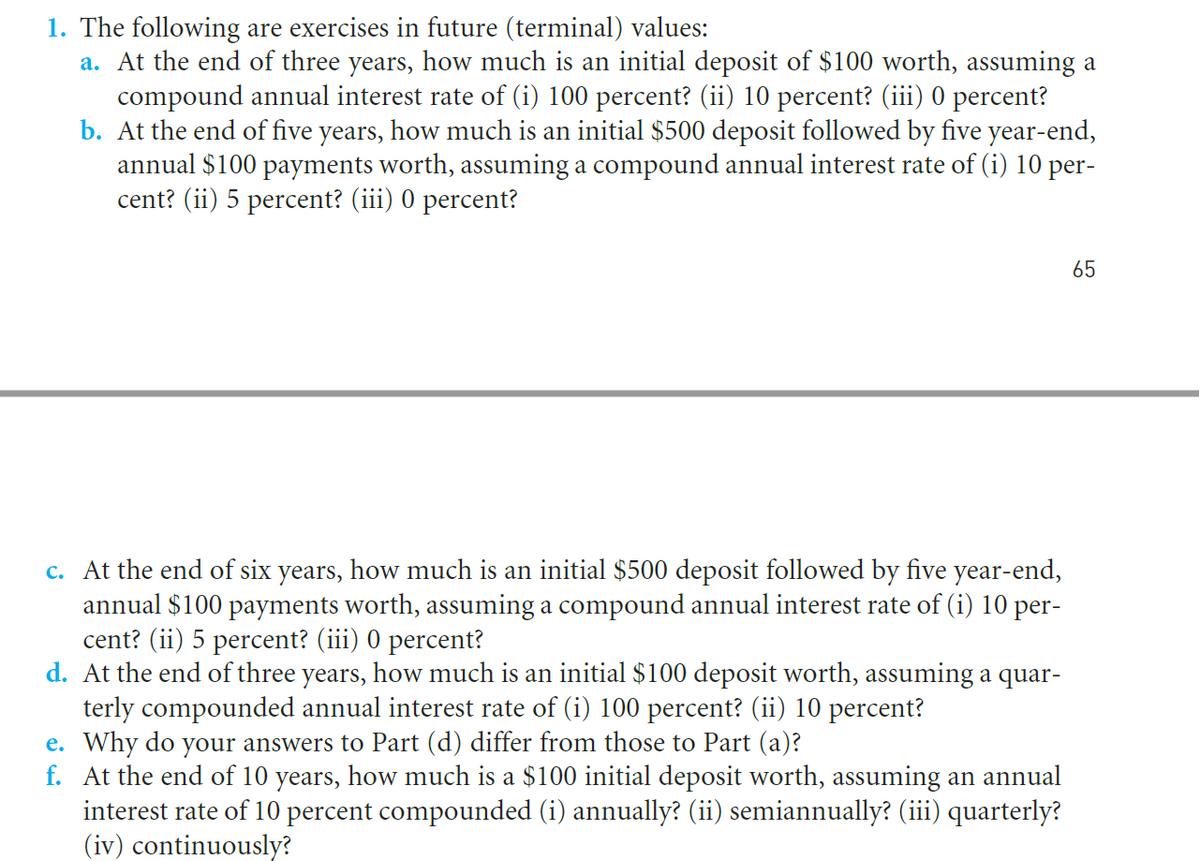d. At the end of three years, how much is an initial $100 deposit worth, assuming a quar- terly compounded annual interest rate of (i) 100 percent? (ii) 10 percent? e. Why do your answers to Part (d) differ from those to Part (a)? f. At the end of 10 years, how much is a $100 initial deposit worth, assuming an annual interest rate of 10 percent compounded (i) annually? (ii) semiannually? (iii) quarterly? (iv) continuously?
d. At the end of three years, how much is an initial $100 deposit worth, assuming a quar- terly compounded annual interest rate of (i) 100 percent? (ii) 10 percent? e. Why do your answers to Part (d) differ from those to Part (a)? f. At the end of 10 years, how much is a $100 initial deposit worth, assuming an annual interest rate of 10 percent compounded (i) annually? (ii) semiannually? (iii) quarterly? (iv) continuously?
Cornerstones of Financial Accounting
4th Edition
ISBN:9781337690881
Author:Jay Rich, Jeff Jones
Publisher:Jay Rich, Jeff Jones
ChapterA3: Time Value Of Money
Section: Chapter Questions
Problem 13E
Related questions
Question
Kindly answer last three parts of Question 1. (d, e, f)

Transcribed Image Text:1. The following are exercises in future (terminal) values:
a. At the end of three years, how much is an initial deposit of $100 worth, assuming a
compound annual interest rate of (i) 100 percent? (ii) 10 percent? (iii) 0 percent?
b. At the end of five years, how much is an initial $500 deposit followed by five year-end,
annual $100 payments worth, assuming a compound annual interest rate of (i) 10 per-
cent? (ii) 5 percent? (iii) 0 percent?
65
c. At the end of six years, how much is an initial $500 deposit followed by five year-end,
annual $100 payments worth, assuming a compound annual interest rate of (i) 10 per-
cent? (ii) 5 percent? (iii) 0 percent?
d. At the end of three years, how much is an initial $100 deposit worth, assuming a quar-
terly compounded annual interest rate of (i) 100 percent? (ii) 10 percent?
e. Why do your answers to Part (d) differ from those to Part (a)?
f. At the end of 10 years, how much is a $100 initial deposit worth, assuming an annual
interest rate of 10 percent compounded (i) annually? (ii) semiannually? (iii) quarterly?
(iv) continuously?
Expert Solution
This question has been solved!
Explore an expertly crafted, step-by-step solution for a thorough understanding of key concepts.
This is a popular solution!
Trending now
This is a popular solution!
Step by step
Solved in 5 steps with 2 images

Recommended textbooks for you

Cornerstones of Financial Accounting
Accounting
ISBN:
9781337690881
Author:
Jay Rich, Jeff Jones
Publisher:
Cengage Learning

EBK CONTEMPORARY FINANCIAL MANAGEMENT
Finance
ISBN:
9781337514835
Author:
MOYER
Publisher:
CENGAGE LEARNING - CONSIGNMENT

Principles of Accounting Volume 2
Accounting
ISBN:
9781947172609
Author:
OpenStax
Publisher:
OpenStax College

Cornerstones of Financial Accounting
Accounting
ISBN:
9781337690881
Author:
Jay Rich, Jeff Jones
Publisher:
Cengage Learning

EBK CONTEMPORARY FINANCIAL MANAGEMENT
Finance
ISBN:
9781337514835
Author:
MOYER
Publisher:
CENGAGE LEARNING - CONSIGNMENT

Principles of Accounting Volume 2
Accounting
ISBN:
9781947172609
Author:
OpenStax
Publisher:
OpenStax College



Principles of Accounting Volume 1
Accounting
ISBN:
9781947172685
Author:
OpenStax
Publisher:
OpenStax College